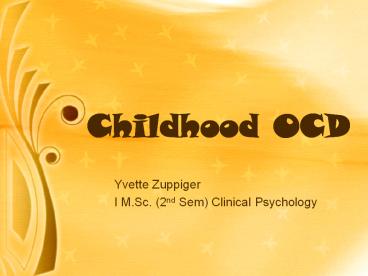OCD - PowerPoint PPT Presentation
Title:
OCD
Description:
OCD – PowerPoint PPT presentation
Number of Views:1567
Title: OCD
1
Childhood OCD
- Yvette Zuppiger
- I M.Sc. (2nd Sem) Clinical Psychology
2
- Obsessive-compulsive disorder (OCD) is an anxiety
disorder marked by recurrent intrusive thoughts
(obsessions) accompanied by repeated attempts to
suppress these thoughts through the performance
of certain ritualistic mental or physical actions
(compulsions) - Majority of OCD cases begin in childhood /
adolescence - Usually diagnosed between ages 7 12
- Difficulties with attention and concentration
because of intrusive thoughts
3
- Low self esteem, shame and embarrassment
- Feel pressured because of time constrains posed
by compulsions / rituals - Frustration, guilt, irritable
- Children are adept at hiding the behaviors from
elders, so OCD can go unnoticed for months or
even years. - Symptoms wax and wane in severity
- Specific content of obsessions and compulsions
may change over time
4
- Aware of lack of reasonableness of obsessions /
compulsions - Indecision, doubt and slowness in completing
tasks - Obsessions and compulsions take more than 1 hour
a day and interfere with persons normal routine - Makes daily life difficult for affected children
and their families. The behaviors often take up a
great deal of time and energy, making it more
difficult to complete tasks, such as homework, or
to enjoy life. - Y-box checklist for OCD developed by Yale Brown
5
Common Obsessions
- Fear of dirt or germs
- Fear of contamination
- Religious obsessions
- Intrusive sounds or words
- Lucky and unlucky numbers
- Sexual or aggressive thoughts
- Need for symmetry, order, and precision
- Preoccupation with body wastes
- Fear of illness or harm to oneself or relatives
- Preoccupation with household items
6
Common Compulsions
- Washing/cleaning
- Counting
- Hoarding
- Checking
- Repeated actions
- Putting objects in a
- certain order
- Repeated "confessing"
- or asking others for
- assurance
7
How To Spot Children With OCD
- Raw, chapped hands from constant washing
- Unusually high rate of soap or paper towel usage
- High, unexplained utility bills
- Sudden drop in test grades
- Unproductive hours spent doing homework
- Holes erased through test papers and homework
- Requests for family members to repeat strange
phrases or keep answering the same question - Persistent fear of illness
8
- Dramatic increase in laundry
- Exceptionally long amount of time spent getting
ready - Continual fear that something terrible will
happen to someone - Constant checks of the health of family members
- Avoidance of scissors or other sharp objects
- Chronic lateness
- Daydreaming or preoccupation
- Hair loss due to frequent hair pulling
- Skin lesions due to frequent skin picking
9
Epidemiology
- Point prevalence 0.5
- Lifetime rate 1-3
- Slight male predominance, which diminishes with
age - Fourth most common psychiatric illness (after
phobias, substance use disorders, and major
depressive disorders)
10
Etiology
- Genetic Factors
- Tends to run in families
- Molecular genetic studies show linkage to
chromosomes 2 9 - Supported by family studies, twin studies and
pedigree studies - Neuroimmunology
- Exposure to Group A beta-hemolytic streptococcus
("strep" throat and Sydenham's chorea) can lead
to the onset of the OCD symptoms
11
- OCD due to infection is termed Pediatric
Autoimmune Neuropsychiatric Disorders Associated
with Streptococcus (PANDAS) - Bacteria activates immune system, leading to
inflammation of basal ganglia and disruption of
cortical-striatal-thalamocortical function - Minority cases
12
- Neurochemistry
- Serotonin system and dopamine system play a role
- Abnormalities in serotonin metabolism
- Increased glucose metabolism in left orbital
frontal, right sensorimotor, and bilateral
prefrontal and anterior cingulate regions (Swedo
et al, 1989)
13
- Neuroimaging
- PET scans indicate brain activity different from
normal pattern - MRI scans show OCD patients have significantly
less white matter in their brains than normal
- CT MRI scans show smaller than normal basal
ganglia segments - Hypermetabolism in frontal cortical-striatal-thala
mo-cortical networks
14
Comorbidity
- Tourettes syndrome
- Anxiety disorders (Social phobia, specific
phobia, panic disorder) - Depression
- Disruptive behaviors (ADHD)
- Learning disorders
- Trichotillomania (compulsive hair pulling)
- Non-verbal learning disorders
- Habit disorders (nail biting, skin plucking)
- Body dysmorphic disorder (BDD)
15
Differential Diagnosis
- Anxiety disorders (Generalized anxiety disorder,
separation anxiety disorder, social phobia) - Pervasive developmental disorders
- Tic disorders (Tourettes syndrome)
- Psychosis
16
Course Prognosis
- Childhood onset OCD has poorest prognosis
- It is chronic, waxing and waning in intensity
- Best prognosis is for those without comorbid
disorders - Up to 50 experience recovery with minimal
remaining symptoms - In children with subthreshold symptoms, high risk
of developing OCD within 2 years
17
Treatment
- Administration of Selective Serotonin Reuptake
Inhibitors (SSRIs), which affect the body's
reabsorption of serotonin (Sertraline,
Fluoxetine) - Cognitive behavior therapy (CBT) change
thoughts and feelings by first changing behavior - Combination of both results in superior outcome
18
(No Transcript)































